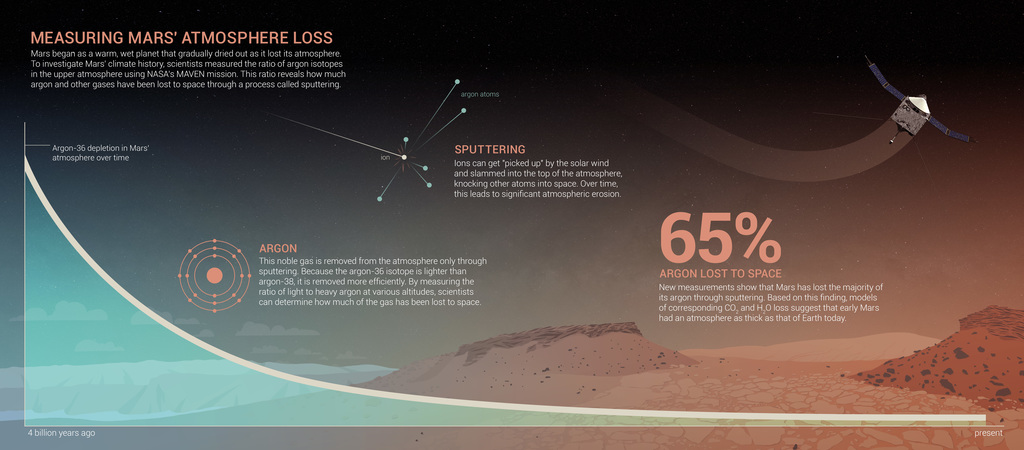Is This How Mars Lost Its Atmosphere?
Mars is losing its atmosphere. Over billions of years, the Red Planet has transformed from a potentially habitable world with lakes, rivers, and a thicker atmosphere into the cold, dry desert we see today. NASA’s MAVEN mission has been tracking this process in real time, catching Mars in the act of slowly sputtering its atmosphere into space.
This phenomenon—called “atmospheric sputtering”—happens when high-energy particles from the Sun slam into Mars’s upper atmosphere, knocking atoms and molecules loose. Without a global magnetic field to protect it, Mars is especially vulnerable. MAVEN has shown that this atmospheric escape accelerates during solar storms, offering a powerful view of how the Sun shapes the evolution of planetary atmospheres.
The data from MAVEN doesn’t just tell us about Mars—it helps us understand how atmospheres behave across the solar system and beyond. It’s a glimpse into what makes a planet stay habitable—or lose that potential entirely.
For more information, visit https://science.nasa.gov/mission/maven/
Credit: NASA's Goddard Space Flight Center
Dan Gallagher: Lead Producer
Paul Morris: Producer / Editor
Dr. Shannon Curry: Scientist / Interviewee
Willow Reed: Public Affairs
Nancy Jones: Public Affairs
Greg Shirah: Data Visualizer
Cindy Starr: Data Visualizer
Kel Elkins: Data Visualizer
Walt Feimer: Animator
Michael Lentz: Animator
Chris Smith: Animator
Jonathan North: Animator
Brian Monroe: Animator
Lisa Poje: Graphic Designer
Adriana Manrique Gutierrez: Graphic Designer
Kim Dongjae: Graphic Designer
Ernie Wright: Support
Aaron E. Lepsch: Technical Support
Music Credit:
"The Greatest Unknown" by Samuel Sim [PRS] via Abbey Road Masters [PRS] and Universal Production Music
Video Credits:
Periodic Table Focusing On Argon With Properties by S_D_Brath via Pond5
Ashes Of A Camp Fire Next To Chair by BlackBoxGuild via Pond5
Wood Burning In A Camp Fire by Edb3_16 via Pond5
Master Version
Horizontal version. This is for use on any YouTube or non-YouTube platform where you want to display the video horizontally.
Vertical Version
This vertical version of the episode is for IGTV or Snapchat. The IGTV episode can be pulled into Instagram Stories and the regular Instagram feed.
Credits
Please give credit for this item to:
NASA's Goddard Space Flight Center. However, please credit individual items as indicated above.
-
Producers
- Dan Gallagher (eMITS)
- Paul Morris (eMITS)
-
Interviewee
- Shannon Curry (University of California, Berkeley)
-
Technical support
- Aaron E. Lepsch (ADNET Systems, Inc.)
Release date
This page was originally published on Thursday, May 29, 2025.
This page was last updated on Wednesday, May 28, 2025 at 1:11 PM EDT.
![During its first decade at Mars, MAVEN has helped to explain how the Red Planet evolved from warm and wet into the cold, dry world we see today. Complete transcript available.Universal Production Music: “Executive Deceit” by Samuel Karl Bohn [PRS], Chalk Music [PRS]; “Quasar” by Ross Stephen Gilmartin [PRS], Chappell Recorded Music Library Ltd [PRS]; “Modular Odyssey” and “Synthology” by Laetitia Frenod [SACEM], Koka Media [SACEM]Watch this video on the NASA Goddard YouTube channel.](/vis/a010000/a014600/a014690/MAVEN-10th-Anniversary-Preview.jpg)

